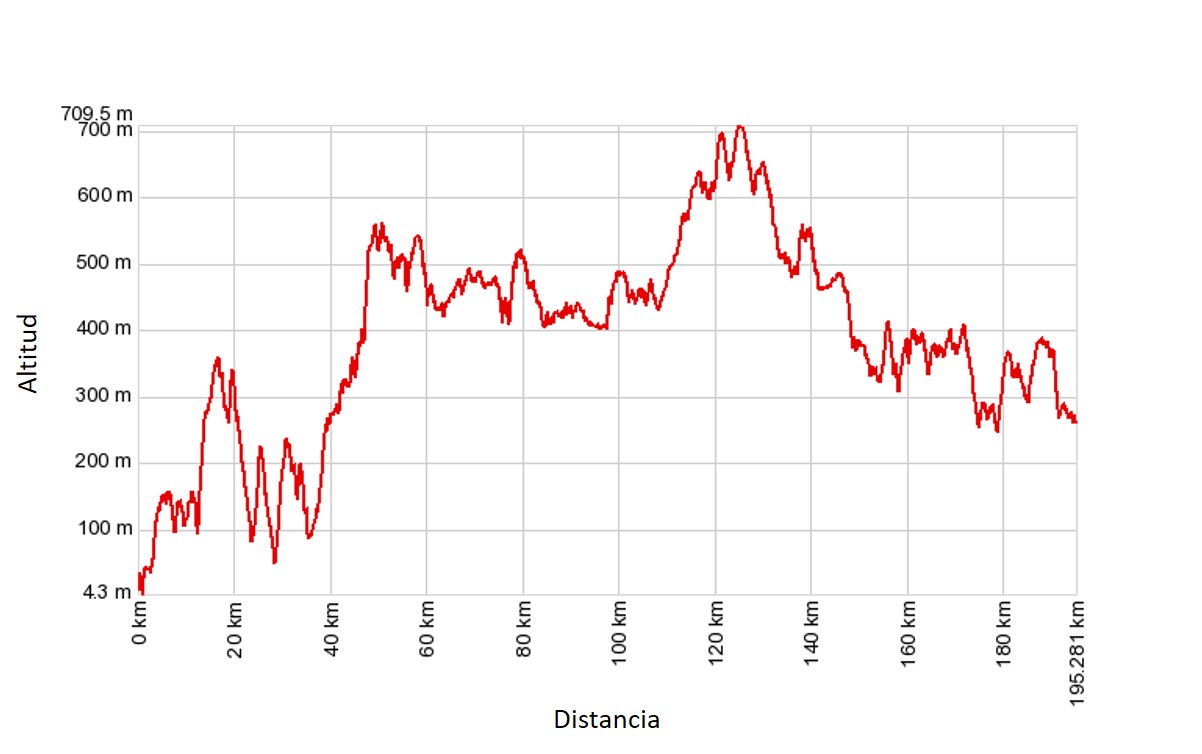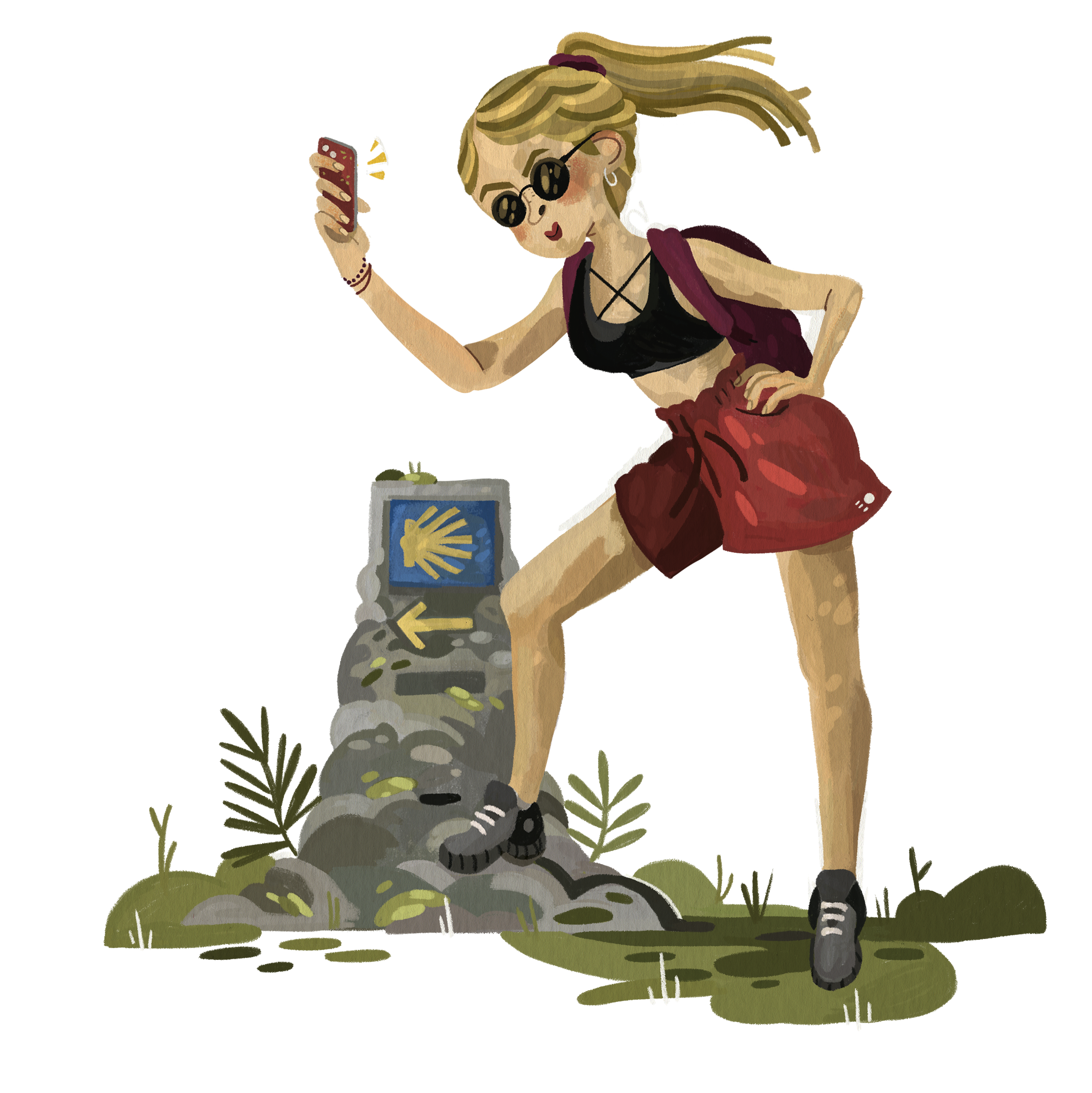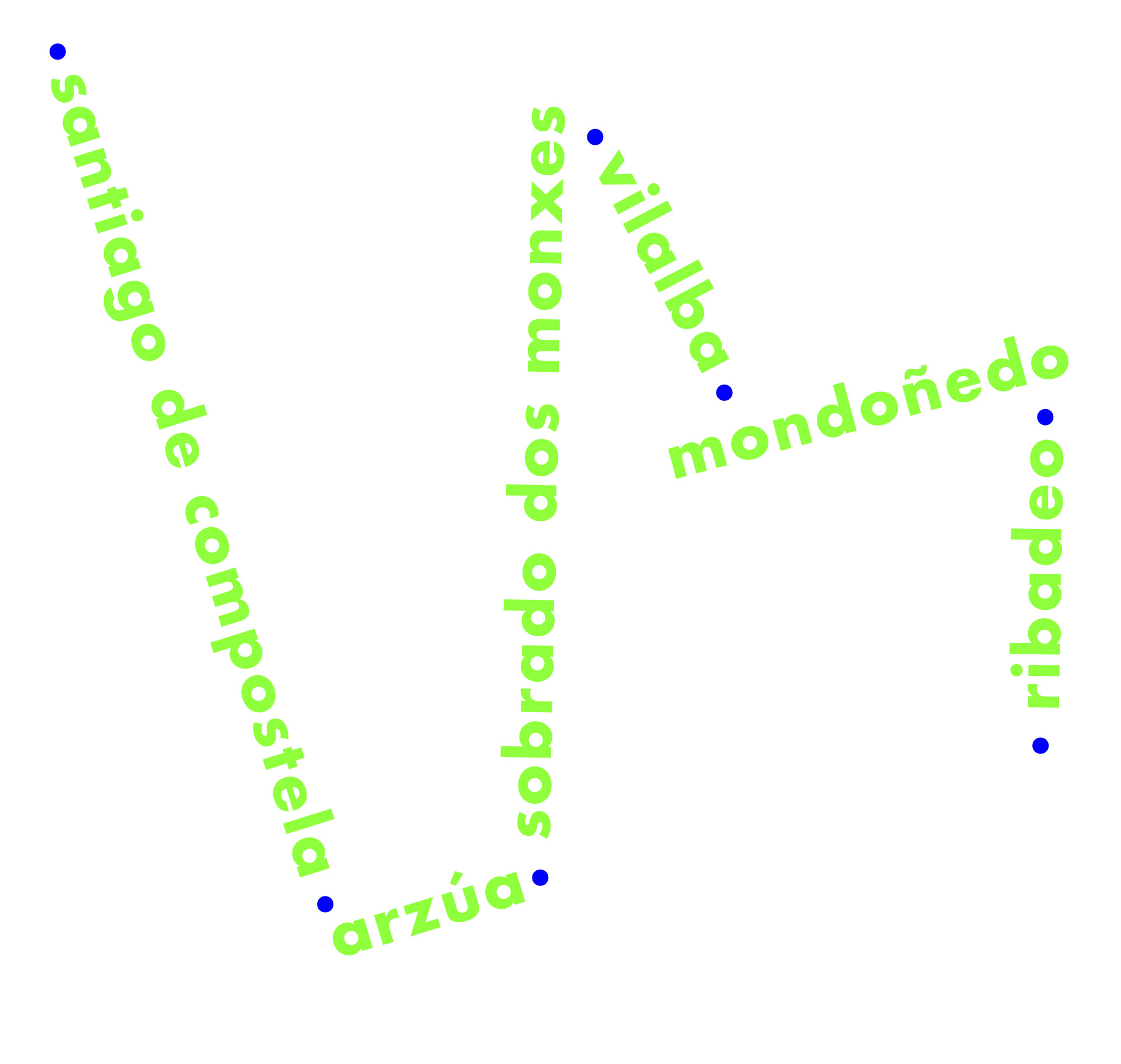the north way
Together with the French, Portuguese and Silver ways, the NORTH WAY is one of the Iberian Peninsula’s greatest historic pilgrimage routes.
Although the exact distances may vary depending on the route chosen (numerous detours may be taken along the Way), it extends more than 800 km from the French border, making it the second longest of the aforementioned ways.
Together with the Primitive Way and other northern trails, in 2015 it was included on the World Heritage list, joining the select group made up exclusively of the French Way and certain sections and monuments to be found along the four historic ways from France.
According to medievalist scholars, pilgrims did not begin to frequent this route until the emergence of the coastal towns, around the end of the Middle Ages, essentially due to the influence of Oviedo, a major centre of worship due to the relics housed in the cathedral’s Holy Chamber.
The exacting terrain, dotted with mountains that lined practically the entire coastline along many stretches, did little to encourage the widespread use of this route, despite the evidence indicating that it was a regular pilgrimage route that included an organised assistance network.
At the start of the third millennium, the indications were that the North Way would be the principal beneficiary of the diversification of the various ways. However, its evolution has failed to meet these initial expectations. Indeed, the numbers appear to have levelled off, positioning this route in fourth place in terms of pilgrims’ preferences, with just 5.5% of the total.
 Mountains, forests, imposing monasteries, cathedrals, and endless solitude are the riches the adventurous pilgrim can boast of.
Mountains, forests, imposing monasteries, cathedrals, and endless solitude are the riches the adventurous pilgrim can boast of.
Irún is the twelfth most popular starting point for the Camino de Santiago, whilst Ribadeo, Vilalba, Baamonde or Mondoñedo attract the pilgrims that choose the shorter route, although the numbers are fairly low.
Users of this way all agree that the backdrop is truly spectacular: verdant landscapes and a perfect mix of coast and mountains. The majority of the towns and villages that line the way are well-kept and boast a considerable wealth of built heritage, undoubtedly enriched by the constructions erected by the indianos – the emigrants that returned after making their fortunes in America. What’s more, the longest route crosses the four communities bathed by the Cantabrian Sea (the Basque Country, Cantabria, Asturias and Galicia), providing a rich cultural diversity.
Despite the considerable progress, this way is often criticised for its excessive number of tarmacked sections, especially in areas of Cantabria; the limited capacity of the hostels, despite the numerous new openings in recent years; and the pressure exerted by tourists in summer, who occupy accommodation destined for pilgrims in the most popular areas.
On reaching Galicia, in Ribadeo the Way heads inland from the coast towards areas that provide a breathtaking backdrop for monumental sites such as the Monastery of Lourenzá, Mondoñedo’s historic quarter, Vilalba Tower or the Monastery of Sobrado dos Monxes.
The large number of alternative routes, some of which are extremely long (particularly in Asturias and Galicia), are an impediment to the clear identification of the actual way itself.
From Ribadeo (190 km) it will take between seven and nine days to complete the route, excluding the mandatory day spent visiting the city of Santiago.


Public transport options are extremely limited, and the journey to Ribadeo will be reminiscent of a sequence in slow motion, even though you choose to disembark at one of the nearby airports (Asturias, A Coruña or Santiago).
-Travel by train is limited to the classic Feve narrow-gauge railway which is now operated by Renfe between Ferrol and Oviedo. The frequencies are few and far between, only suitable for those willing to take things slowly (unbelievably, the route between Oviedo and Ribadeo takes 4 hours, although its costs just €12.50), ideal for those willing to seek enjoyment in the journey and admire the magnificent coastal scenery.
-The coach is therefore the best option Alsa operates a direct route from Madrid and Terminal 4 at the Adolfo Suárez Airport, calling at Benavente, Ponferrada and Lugo (+8 hours, +€45); there is also a direct route from Avilés (approximately 3 hours, €15.85) and Oviedo (3 hours or a little longer, €17.45). In Galicia, Arriva connects A Coruña (2 hours 10 minutes, + €12) and Lugo, via Mondoñedo, or Meira (the fastest service takes just 1 hour 40 minutes and costs +€7) and Ribadeo.
sections
ribadeo – vilalba






THE RIBADEO-VILALBA STRETCH (69.74 km)
description
For a couple of days we will be unable to catch sight of any expanse of flat terrain. The succession of uphill and downhill climbs begins as soon as we leave Ribadeo, where the sight of the traditional villas that line the A Mariña coastline in the province of Lugo will soon be replaced by country landscapes dotted with large stone houses with their characteristic slate roofs.



The valleys that crisscross the Way include the River Lexoso, which we cross via Arante bridge.
We make our way through vast eucalyptus forests, with cattle farms nestling in the lower areas, before climbing a steep slope up to Mount Móndigo, which will bring us to Vilamartín Pequeno, followed by an equally challenging climb to Vilamartín Grande.
By the time we arrive in Gondán, and the hostel, the sea is well behind us, and we are now surrounded by mountains, although unquestionably gentler than the ranges of Asturias or Cantabria. A final climb remains before coming to Vilanova de Lourenzá, a town where the apartment buildings compete in height with the church tower, which belongs to the Monastery of El Salvador.
The route to Mondoñedo takes us through similar landscapes, although we can admire the chestnut groves and a number of villages boasting fine examples of traditional architecture. The episcopal city, where time seems to have stood still, appears as the magical setting described by its most famous son, Álvaro Cunqueiro.
Magic is a bridge that allows you to walk from the visible world over into the invisible world, and learn the lessons of both those worlds. (Paulo Coelho)
The historic route, which passes by the Chapel of O Remedios on its way out of Mondoñedo, will take us along one of the steepest and most solitary stretches of the Way as far as Porto da Calzada de Cabana Vella – literally the Old Hut Road Pass, a name which if it were not in Galician, could well come straight out of The Lord of the Rings.


![]()
![]()
![]()
![]()
We finally leave the mountains behind us, entering the region known as Terra Chá from Gontán and after passing through Abadín. The autochthonous woods, dominated by large expanses of birch trees and pastureland, gradually gain ground over the tedious monoculture forests of eucalyptus trees.
We cross the 17th century Martiñán bridge via a well-conserved stretch of the Royal Highway, before passing by the Church of Santiago in Goiriz, taking time to admire the intriguing decorative elements of its cemetery. A business park, where the public hostel is located, marks the entrance to Vilalba, the capital of this large area.
Our suggestions
–Ribadeo, an impeccably kept town with immense tourist appeal awaits you. Plaza de España houses the striking Los Moreno Tower, an example of indiano architecture more in keeping with Barcelona’s Eixample district, overshadowing the 18th century palace that was once the home of the Marquis of Sargadelos, and now houses the Town Hall. Don’t miss the chance to enjoy a stroll along the Porcillán waterfront, and for those spending the night in the public hostel, San Damián Fortress and the lighthouse on Pancha Island are both within easy reach. Dos Santos Bridge, which crosses the tidal estuary, was used by pilgrims travelling from Asturias, with the towns of Filgueiras, and slightly further inland Castropol, nestling on the opposite shore.
-If you have some time to spare in Ribadeo, remember that in summer a shuttle bus service operates four times a day, coinciding with low tide. Departing from the Tourist Information Office, it takes visitors to Augasantas Beach, better known as the Cathedrals Beach (Return fare: €2.50). The ticket allows you to visit the sands, where access is limited during the high season.



-The route takes you so close to Mount Santa Cruz that it would be a shame not to stay a little off the signposted path. From the top, 186 metres above sea level, you will catch a final glimpse of the Cantabrian Sea and Ribadeo tidal estuary. There is an excellent recreation area around the chapel, which boasts a monument to the Piper and La Luz Cross.
–Shrine of As Virtudes de Arante. This apparently unassuming chapel houses a series of fascinating Gothic murals, include one that relates a miracle at sea in intricate detail.
– Gondán is an ideal spot for relaxing or spending the night. Surrounded by mountains, there is a picnic area next to the hostel.
-Not to be missed is a visit to the Monastery of San Salvador de Lourenzá. The ornate Baroque façade is a truly magnificent sight. It was completed by Fernando de Casas Novoa, the architect that designed the Obradoiro façade of Santiago Cathedral. The monastery museum houses two outstanding exhibits: the marble Paleochristian tomb of the Holy Count and the large Baroque reliquary from the vestry.
–Mondoñedo is a worthy end of stretch, as it enables visitors to roam the magnificent historic quarter and discover its many treasures: 1. The Romanesque-Gothic cathedral with its Baroque details on the façade, and a 16th century mural depicting the Massacre of the Innocents and a superb cathedral museum, home to numerous treasures (€3 for pilgrims); 2. The Álvaro Cunqueiro House Museum (€1), an excellent opportunity to learn about the town’s most distinguished writer and talented fabulist ; 3. The historic quarter itself, which is well worth strolling around at leisure; 4. The North Way Visitor and Interpretation Centre, located in the cultural centre at the Convent of Alcántara; 5. Try a slice of Mondoñedo tart, made with flaky pastry, threaded pumpkin ham, almonds and fruit dripping in delicious syrup; 6. Take a stroll around the renovated Os Muiños district and the ancient Pasatempo Bridge; 7. And if you are eager for more, in good shape and do not suffer from claustrophobia, then sign up at the Tourist Information Office for a guided tour of the Rei Cintolo Cave (advance phone bookings on 982 507 177, €15), which is not quite so sophisticated as the famous Drach Cave on Majorca (we guarantee you’ll get dirty).
vegadeo- mondoñedo






ALTERNATIVE ROUTE: VEGADEO-MONDOÑEDO (39.1 km)
description
In Asturias, the general conviction is that the principal Way takes pilgrims through Vegadeo/A Veiga, avoiding Ribadeo and which due to the lack of accommodation facilities, currently lacks widespread acceptance.
This is a fairly challenging route, featuring a series of uphill climbs and long solitary walks through seemingly endless eucalyptus forests. Making way through the tall trees swaying in the wind, overshadowed only by the sequoia, the sensation is a truly humbling experience. The triumph of this Australian species is a perfect representation of the philosophy of those that think only of the present.
Plant eucalyptus trees for yourself, pines for your children and oaks for your grandchildren (proverb), a notion expressed by Chinese philosophy as “One generation plants the trees and another gets the shade“. 前人栽树,后人乘凉。
On leaving Vegadeo, we soon begin to make our way up Parga Hill before returning to the River Eo via Santiago de Abres. Heading towards Sante Valley, there are another two uphill climbs along forest paths, as far as Trabada, and 1 km further along is the Casa Xica hostel.
Another uphill stretch, even steeper than the previous ones, takes us over the Serra da Cadeira mountain range, before making our way down to the fertile Lourenzá Valley, site of the Tovar fortified manor house and the Church of San Tomé.
A final climb brings us to Lindín, which is followed by yet another steep descent below the highway, before leading into Mondoñedo over Pasatempo Bridge.
Our suggestions
-Take the time to explore the ancient Tovar Fortress, which became a stately home in the 16th century. Gastronomy lovers should try the delicious Lourenzá beans, which hold a Protected Geographical Indication quality seal.
vilalba – sobrado dos monxes






THE VILALBA-SOBRADO DOS MONXES STRETCH (59.7 km)
description
We continue our journey through the Terra Chá, the vast plains of the province of Lugo, where we will no longer find any large towns, but instead is peppered with tiny villages, until we reach the peace of the cloisters on the other side of the mountain.
Humility is the solid foundation of all virtues. (Confucius)
We leave Vilalba via the delightful park on the banks of the River Madalena, which leads us to the medieval bridge known as Ponte Rodríguez. As we make our way towards Baamonde, a necessary stopping point due to the wide range of services it provides, we will pass by the Cantabria highway and the N 634 road.


![]()
![]()
![]()
![]()



Leaving behind us the magical San Alberte, the Parga detour soon forks, although the main route leading directly to Sobrado carries straight on, through the hamlets of San Breixo and Santa Locaia, in an area with a number of hostels located just before Miraz.
The countryside becomes more open as we make our way through a livestock farming area, embarking on a gentle climb up to Marco das Pías, in the Serra da Cova da Serpe hills, topped by a windfarm, which marks the boundary between Lugo and A Coruña.
From here on, we will observe that the roofs are made of tile rather than slate. A downhill walk will bring us to Sobrado dos Monxes, past the artificial lake that was constructed in the 16th century by the monks to drive the watermill and to guarantee them a regular supply of fish.
Our suggestions
-Despite its limited size, Baamonde, situated on the crossroads of the roads leading to Castile and Oviedo, holds a threefold interest for visitors: the 14th century Gothic Church of Santiago, in front of which stands an ancient hollow chestnut tree carved by Víctor Corral; the Mesón Galicia tavern, one of the oldest in Galicia, is the ideal place to stop and enjoy a delicious meal in a setting worthy of a museum, decorated with utensils of yesteryear; and a short distance away, stands the house-museum honouring the sculptor that carved the chestnut tree, with its garden and two rooms overflowing with his creations.
-Take a well-earned break in the charmingly quaint village of San Alberte, site of a medieval bridge and chapel, the 18th century holy fountain and a magnificent carballeira, or chestnut grove.
-Although you choose not to spend the night there, take the time to stamp your pilgrim’s credentials and chat to the staff at the Miraz parish hostel, which is run by the British Confraternity of Saint James. The revival of the North Way has breathed new life into this village.
-A tour of the Cistercian Monastery of Santa María de Sobrado dos Monxes, one of the largest in Galicia. The original medieval chapter house, kitchens and a chapel can still be admired, whilst the huge monumental church, with its Baroque façade built in a clearly colonial style, dates back to the 17th century. There are also three cloisters, the most notable of which is the 16th century ‘Medallion’ cloister. The Pilgrims’ cloister houses the hostel.
sobrado dos monxes – santiago






THE SOBRADO DOS MONXES-SANTIAGO DE COMPOSTELA STRETCH (61.5 km)
description
In the manner of a river tributary, in Arzúa, the North Way flows into a far larger route, the FRENCH WAY. From then on, nothing will be the same, although fortunately, Santiago de Compostela is now just a short distance away.
Heraclitus may have said that no man ever steps in the same river twice (Heraclitus), yet we find consolation in the words of Plautus, as by following the river we come to the sea.
From the Pontepedra recreation area we embark on our exploration of Terra de Melide along a series of ancient paths. From As Corredoiras onwards, we will make our way through farmland and eventually along the road to the town of A Gándara, capital of the borough of Boimorto, where the road forks once more.
Making our way through Sendelle, the succession of Cartesian-style meadowlands lead us to Arzúa, which we enter via the local fairground. The village, modern and stretched out over the N-547, features a lively boulevard and the Gothic Madalena chapel (14th century).
You have to continue along broken terrain to cross the As Barrosas stream, which is followed by a steep climb. Here, eucalyptus plantations coexist with cattle pastures, although there are usually oak trees along the way.
The toponyms associated with the path mark this route: Tabernavella, Calzada, Calle, A Brea, and A Rúa. In Salceda, you can see a simple monument memorialising the pilgrim Guillermo Watt, who died here in 1993; it is not the only one, as there are several on the French Way in recent years, which is a contrast with the anonymity of those who perished along the route in the past.
From O Empalme, a crossroads with bars and restaurants, you go down to Santa Irene, where the fountain and chapel are often ignored by pilgrims. A common final stage for making the final jump to Santiago is O Pedrouzo, the capital of the council of O Pino. It is another modern centre, full of hostels and pensions, grouped around the national road.
 In Arzúa it will be delightful to join up with the lively comings and goings of lively French Way ( I fail to understand why some pilgrims are so reluctant to take part in merriment and revelry).
In Arzúa it will be delightful to join up with the lively comings and goings of lively French Way ( I fail to understand why some pilgrims are so reluctant to take part in merriment and revelry).
The last stages take us to Amenal, where the way up to Barreira Peak begins. A second business park was also planned here, as in Melide – it seems we do not learn from the mistakes of the past to protect the way! The route was covered by the airport of Lavacolla and passes under the access road.
In Lavacolla, pilgrims historically used to wash themselves in its modest stream before reaching Compostela. The last slope extends to Vilamaior. The way continues through a new eucalyptus plantation to San Marcos and its chapel and to Monte do Gozo. Finally, the pilgrims can see the cathedral towers and the final goal of the pilgrimage.
There is little to say about the entrance to Santiago, although the route is being improved for the holy year of 2021. In a way, at this point, the route is unimportant because what matters is about to appear. We will not get into details about the section between the San Lázaro quarter and the charming Rúa de San Pedro. This street leads to the old town through the Porta do Camiño. The Casas Reais, Praza de Cervantes and Acibechería leave you in front of the cathedral. You have arrived at Santiago de Compostela.
All good things come to an end. However, in this case, the short final stages will not seem twice as good, but rather frustrating as we have already reached the point of the pilgrimage. Some will be satisfied by meeting the goal itself, but to the most restless people, completing the pilgrimage will seem like only the beginning, possibly of a farewell.
We have forgotten that our only goal is to live and that life is what we do every day and at all hours of the day we achieve our real goal if we live. (Jean Giono)
Our suggestions
We recommend a visit to Boimorto hostel, which stands right on the way just before coming to A Gándara. Next door is a large 19th century tile factory that has been restored. At the rear you will find a lake inhabited by ducks.
– In Arzúa be sure to try the local cow’s cheese. Protected under the designation of origin, Arzúa-Ulloa, with a soft texture and cylindrical, flattened form, it is, along with the tetilla cheese, the best-known cheese of Galicia. We advise you try the farmhouse kind made with raw milk, if possible. Enjoy!
– It’s shocking that today we don’t know for sure exactly where Monte do Gozo was. Of French origin (Montjoie), it is called Monxoi in Galician. In the past, it gave rise to many emotions. It was also witnessed crazy races to determine who would be the first to see the towers of the cathedral and be proclaimed by his companions ‘the king of the retinue’. It’s fine to settle for the sculptural monument in memory of John Paul II’s visit (1989) at the edge of the way, but from the neighbouring hill, decorated with the figures of ecstatic pilgrims, the experience is much more rewarding.
baamonde – santiago






ALTERNATIVE ROUTES FROM BAAMONDE TO SANTIAGO DE COMPOSTELA (72.57 km)
description
Traditional short cuts to reach Santiago at the earliest opportunity; the pilgrims of the past were not fond of lengthy detours. The signposting is deceptive; this terrain has not been properly prepared, and we pilgrims must therefore pay the price.
As the popular saying goes, this is a case of putting the cart before the horse.
The first detour runs from Baamonde to Boimorto. Leaving behind San Alberte to the right, it goes past Pobra de Parga, but without entering the town. It then continues uphill along a solitary wooded path to the top of the Serra da Cova da Serpe hills and runs alongside the provincial road as far as Cruces crossroads. From here we can make our way down to Sobrado dos Monxes.
From As Cruces there is a signposted route leading directly to San Miguel de Boimil, where it joins up with the main route just before A Gándara. Practically all of this route runs through wooded areas.
![]()
![]()
![]()
![]()


The second detour, which some may take unwittingly, is situated on the road leading out of A Gándara, leading directly to Lavacolla. The first few kilometres run along the DP 0603 road, where the only distraction is the sight of A Mota Chapel.
After crossing the Pontecarreira to Arzúa road, the route takes us over Vilar Hill before making our way downhill to the Santo André Chapel and the N 634 road.
From here we follow the tracks and paths that run alongside the busy main road as far as Santiso, retracing the ancient Roman Via XIX. It joins up with the French Way at the roundabout leading to Lavacolla Airport, a mere 12.9 km from the Cathedral.
Our suggestions
-There is little to say about these detours except that we trust you will find these options to your liking and that they are particularly suited to all those that appreciate solitude.
-The most delightful spot on both stretches is undoubtedly A Mota Chapel, dedicated to Saint Bartholomew, and where pilgrims would spend the night before embarking on the final stretch that led them straight to Santiago. Today only a few would brave spending the night under its portico, or in the surrounding oakwood.







